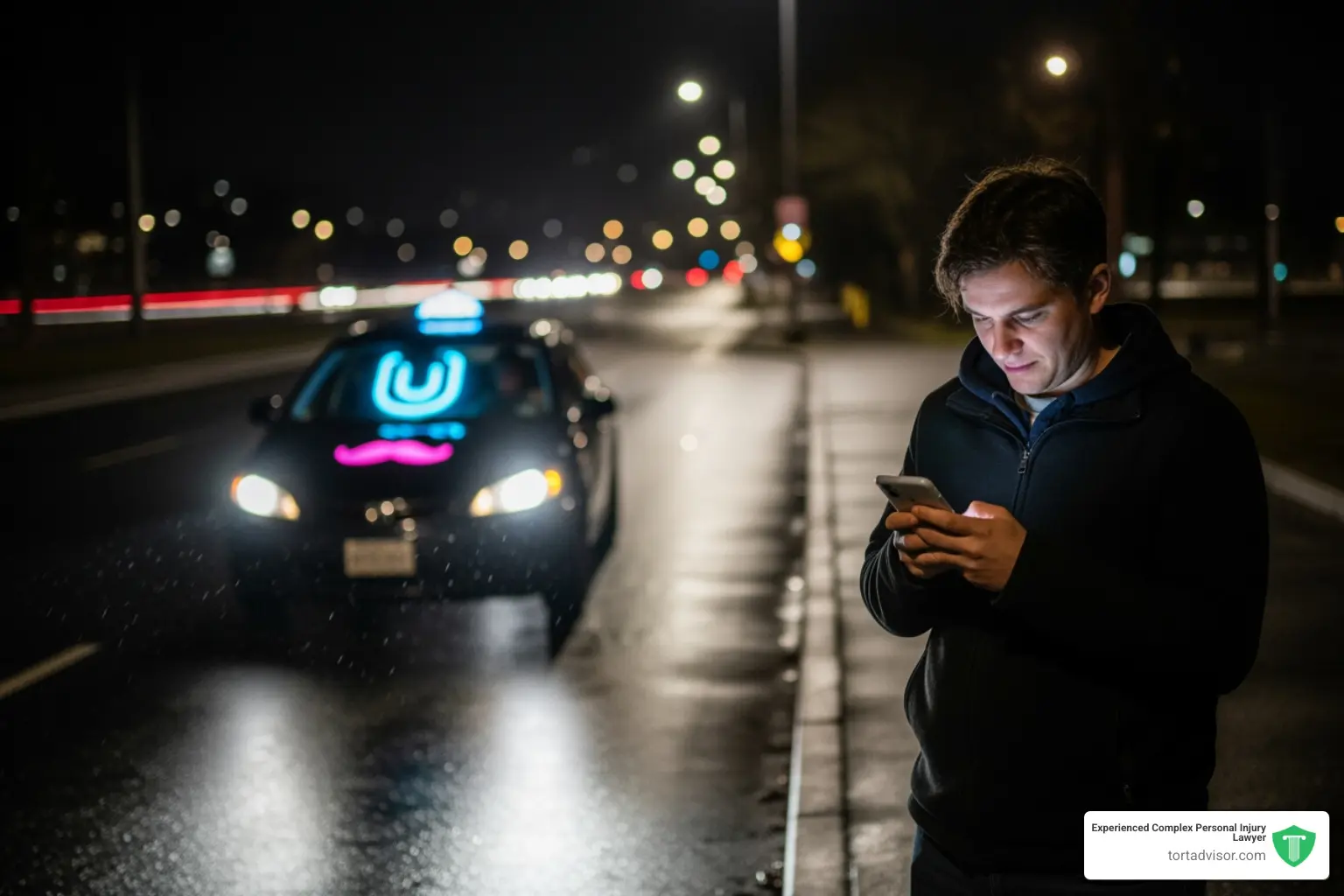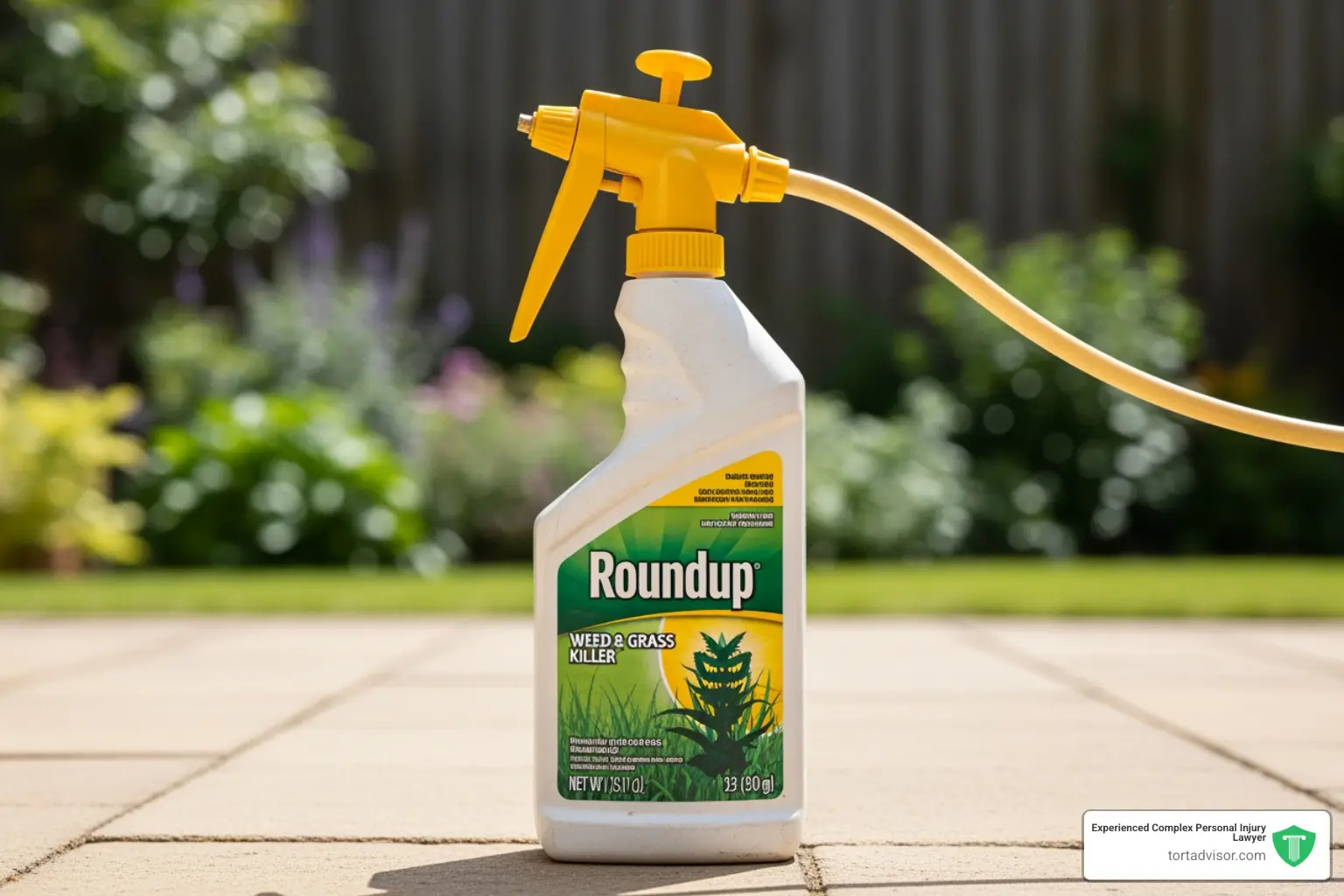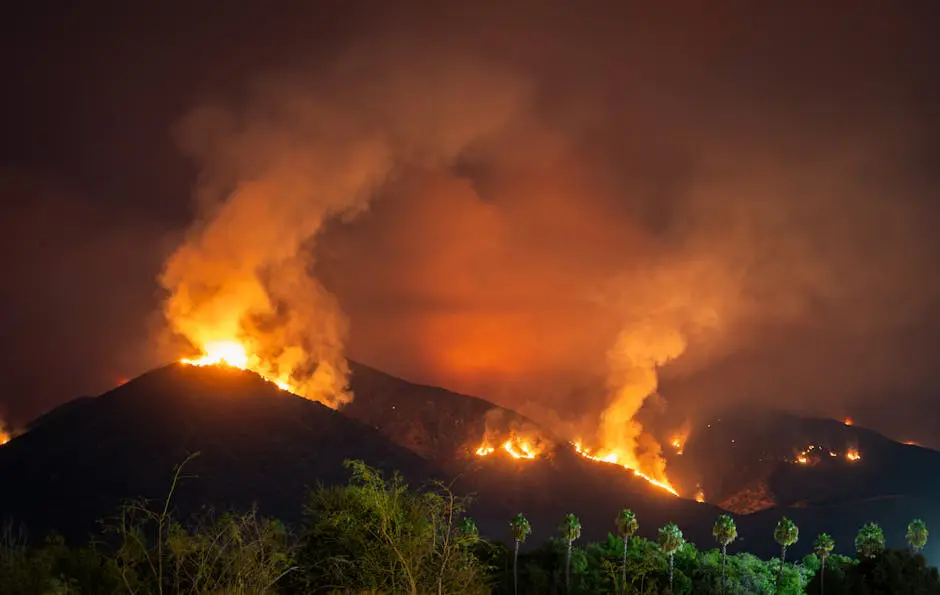


When Wildfires Turn Deadly: Understanding Your Legal Rights
California wildfire wrongful death cases arise when preventable deaths occur due to negligence in fire ignition, spread, or emergency response. These legal claims allow surviving family members to seek compensation and accountability from utility companies, government agencies, or other responsible parties.
Key Facts About California Wildfire Wrongful Death Claims:
- Who can file: Surviving spouse, children, parents, or estate representative
- Common causes: Power line failures, delayed evacuations, inadequate water supply
- Typical defendants: Utility companies (PG&E, SCE), government agencies, property owners
- Compensation includes: Medical costs, funeral expenses, lost income, emotional distress
- Filing deadline: 2 years for personal injury, 6 months for government claims
- Recent major cases: Camp Fire ($13.5B settlement), Eaton Fire (ongoing litigation)
Two of California’s top 10 deadliest fires happened in 2025 alone – the Eaton Fire killed 18 people while the Palisades Fire claimed 12 lives. The 2018 Camp Fire remains the deadliest with 85 victims.
Many of these deaths weren’t inevitable natural disasters – they often resulted from utility company negligence, failed infrastructure, or inadequate emergency response.
I’m Mason Arnao, and through my work in technology and data management, I’ve helped legal teams analyze complex wildfire cases and understand the patterns behind California wildfire wrongful death litigation.
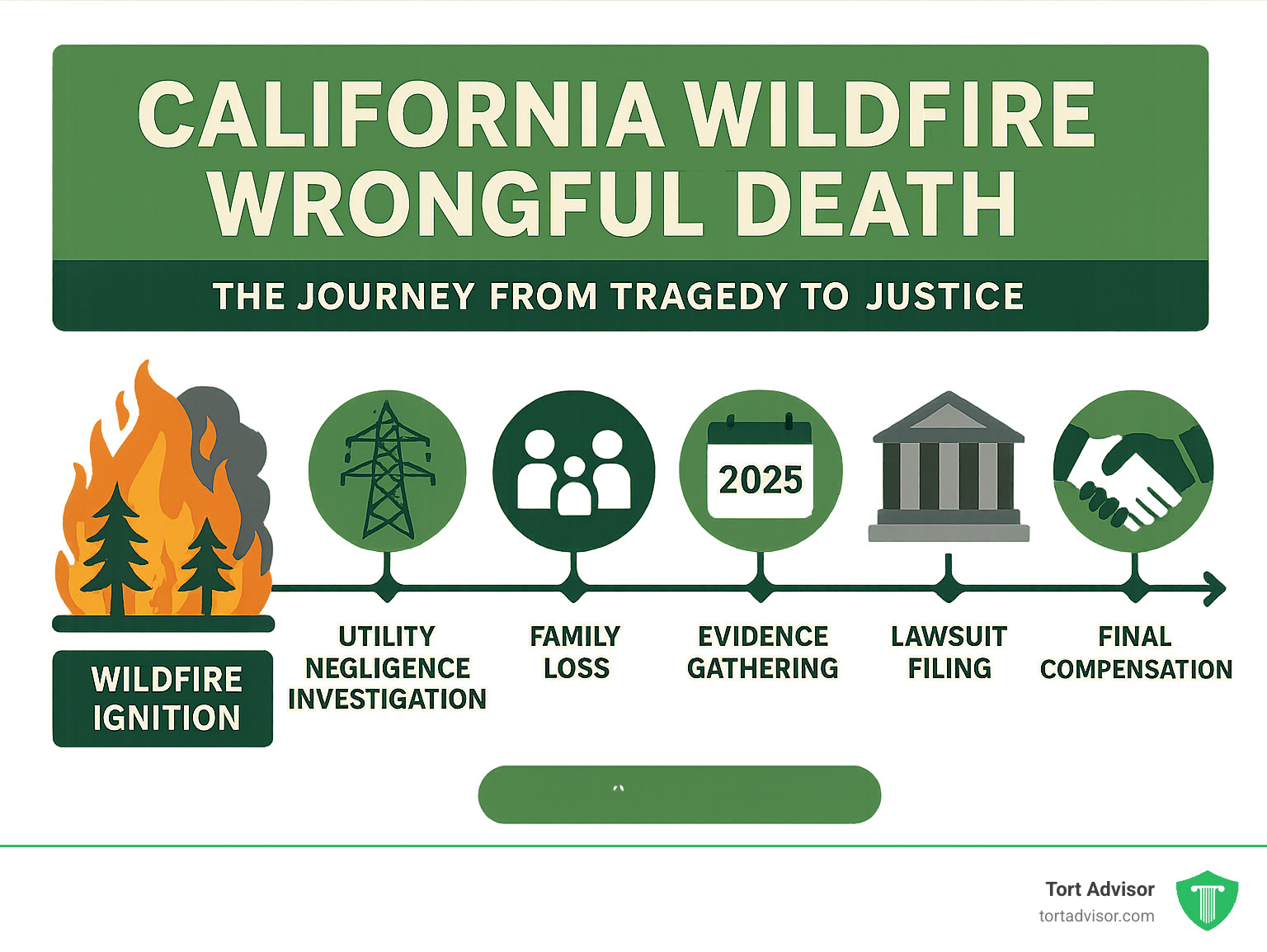
Why This Guide Matters
When families lose loved ones in California wildfires, they’re often overwhelmed by grief while facing mounting financial pressures. This guide helps families understand their legal rights, connect with qualified attorneys, and steer the complex path toward justice and compensation.
This guide also serves the broader community by highlighting how legal accountability can drive systemic changes in utility maintenance, emergency response protocols, and wildfire prevention measures.
What Counts as a California Wildfire Wrongful Death?
Under California Code of Civil Procedure § 377.60, a California wildfire wrongful death happens when someone dies because of another party’s “wrongful act or neglect.”
This legal definition makes an important distinction. Not every wildfire death qualifies as wrongful death – the law requires proof that someone’s negligence or misconduct caused or contributed to the death.
The law recognizes two separate types of claims. Wrongful death claims are filed by surviving family members to recover compensation for their own losses. Meanwhile, survival actions represent the claim the deceased person would have pursued if they had lived.
Common Causes Behind a California Wildfire Wrongful Death
Most deadly California wildfires aren’t acts of nature – they’re preventable tragedies rooted in human failures.
Power line failures top the list of causes behind wrongful death claims. Aging infrastructure sparks during high winds, utility companies fail to manage vegetation around power lines properly, and equipment goes without adequate maintenance.
Southern California Edison now faces over 40 lawsuits related to the Eaton Fire, with evidence pointing to their equipment as a potential ignition source. PG&E’s negligence in the 2018 Camp Fire led to 85 deaths and ultimately a $13.5 billion settlement.
Delayed evacuation orders represent another tragic category of negligence. When agencies fail to issue timely warnings or emergency communication systems break down, people die who could have been saved. Many Eaton Fire victims never received evacuation warnings, even as crosswinds reached 100 mph.
Inadequate water supply during firefighting operations has become a recurring issue. The Palisades Fire litigation focuses partly on the Santa Ynez Reservoir being offline due to cost-saving measures, hampering firefighting efforts when every minute counted.
How Recent Fires Shape Wrongful Death Claims
California’s top 10 deadliest fires tell the story of how California wildfire wrongful death litigation has evolved.
The 2018 Camp Fire changed everything. With 85 deaths and $16.5 billion in damages, it established crucial precedents. PG&E pleaded guilty to 84 counts of involuntary manslaughter, marking the first time a utility company faced criminal liability for wildfire deaths.
The 2025 Eaton Fire demonstrates how these precedents apply to current cases. With 18 deaths, multiple wrongful death lawsuits target Southern California Edison’s equipment failures and inadequate maintenance.
These cases show that California wildfire wrongful death litigation has matured into a powerful tool for holding utilities and government agencies accountable.
Who Can File & Whom Can You Sue?
California law provides clear guidance on who can pursue justice through a California wildfire wrongful death claim, establishing specific priorities to prevent conflicts between family members.
California Wildfire Wrongful Death Claimants’ Priority Order
California Code of Civil Procedure § 377.60 creates a clear hierarchy of who can file wrongful death claims.
The surviving spouse or domestic partner holds the highest priority. They can file not only for their own losses but also on behalf of minor children.
Children come next in line, including stepchildren who were financially dependent on the deceased. Adult children can file their own claims independently, while minor children are typically represented by the surviving parent.
Parents can file if no spouse or children survive. However, they must show they were financially or emotionally dependent on their adult child.
Other dependent family members might have rights too, but they’re lower on the priority list. This could include siblings, grandparents, or other relatives who relied on the deceased for financial support.
Finally, an estate representative appointed by the probate court can file if no eligible family members exist.
Potential Defendants in a California Wildfire Wrongful Death
The question of who to sue depends entirely on what caused the fire and led to your loved one’s death. California’s recent fires have shown us that responsibility often lies with multiple parties.
Utility companies are frequently the primary defendants. Pacific Gas & Electric (PG&E) serves Northern California and has faced massive liability for fires like the deadly Camp Fire. Southern California Edison (SCE) is currently facing over 40 lawsuits related to the Eaton Fire. Los Angeles Department of Water and Power (LADWP) and San Diego Gas & Electric (SDG&E) have also faced wildfire litigation.
Government agencies present another avenue for accountability. Cal Fire, local fire departments, and emergency management agencies can face liability for delayed response times, inadequate evacuation orders, or infrastructure failures.
Property owners and developers sometimes share responsibility for failing to maintain vegetation around power lines or building in high-risk areas without proper safety measures.
Equipment manufacturers round out the potential defendants, including companies that make power lines, transformers, or emergency communication systems that fail when lives depend on them.
For families navigating these complex cases, More info about Personal Injury Lawsuits can help you understand how wrongful death claims fit into the broader landscape of personal injury law.
Proving Liability & Preserving Evidence
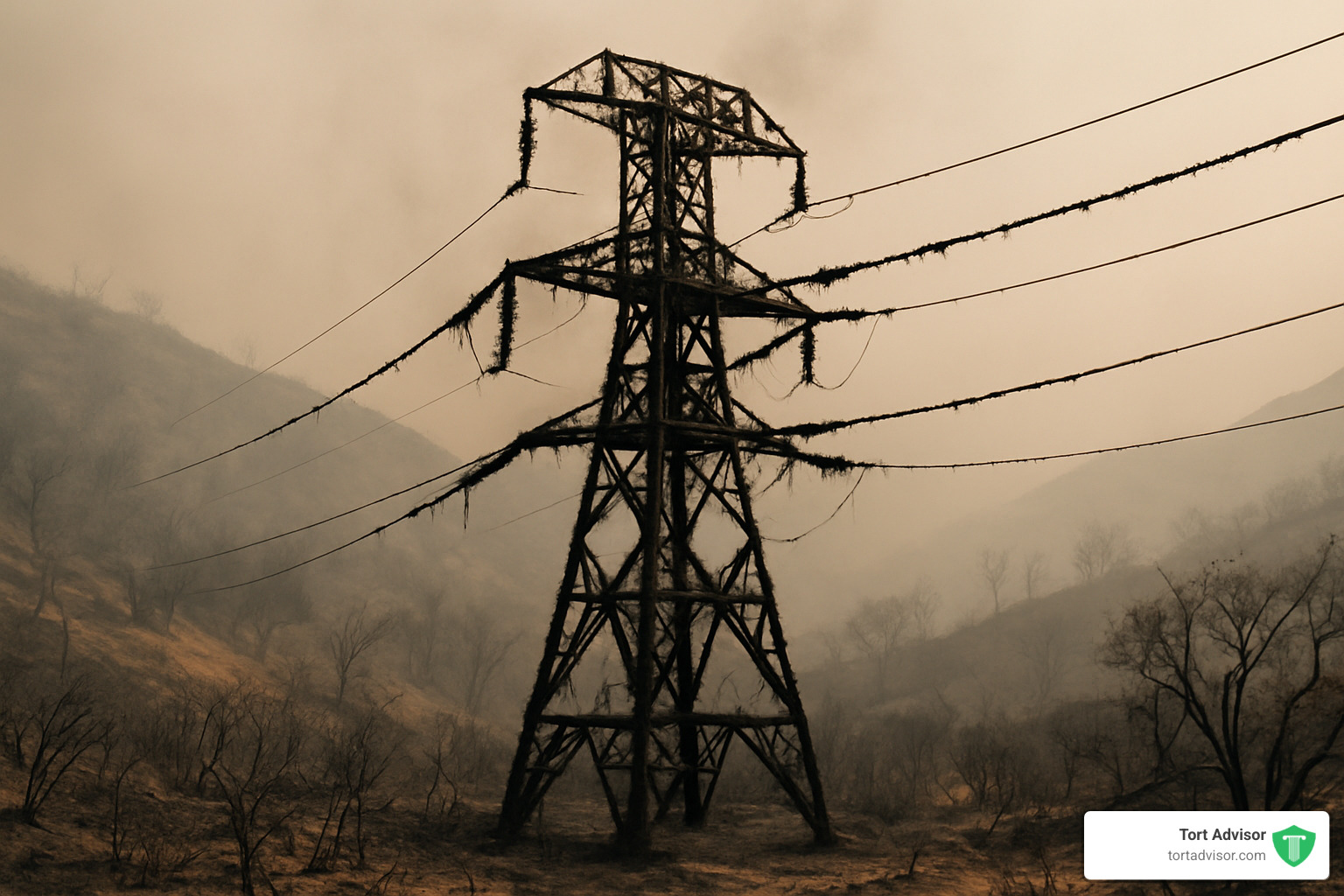
In California wildfire wrongful death cases, families must show that someone’s negligence or wrongful actions caused or contributed to their loved one’s death. Time works against grieving families as fire scenes change rapidly, making quick evidence preservation crucial.
Evidence Checklist for a California Wildfire Wrongful Death
Building a strong case requires gathering evidence from multiple sources.
Fire origin investigations form the foundation of most cases. Fire departments and independent investigators analyze burn patterns to determine where and how the fire started.
Utility maintenance logs often reveal the smoking gun in power line-related fires. These records show whether companies followed proper inspection schedules and maintained equipment properly.
Weather data and wind conditions during ignition help establish whether utilities should have shut off power during dangerous conditions.
Emergency response documentation includes 911 call recordings, evacuation order timelines, and coordination between agencies.
Autopsy records and medical documentation establish the cause of death and connect the fire directly to the victim’s death.
Drone imagery and cell phone videos captured during the fire provide powerful visual evidence of conditions and emergency response.
Expert testimony ties all the evidence together through fire investigation specialists, electrical engineering experts, and emergency management consultants.
For families dealing with these complex cases, Wildfire Lawsuits provides specialized legal guidance on gathering and preserving crucial evidence.
Insurance Claim vs. Wrongful Death Lawsuit Comparison
Insurance claims provide faster relief but limited recovery. They’re typically resolved within months to a couple years, but families can only recover what their policy covers.
Wrongful death lawsuits take longer but offer comprehensive compensation. These cases can take 2-5 years or more, but they allow families to recover the full range of damages and hold responsible parties accountable.
The scope of recovery differs dramatically. Insurance claims are limited to policy terms, while wrongful death lawsuits can recover funeral costs, lost income, loss of companionship, and even punitive damages.
The Camp Fire cases show how both approaches can work together. Many families received initial insurance payouts while pursuing the larger $13.5 billion settlement against PG&E.
Compensation, Deadlines & Key Legal Milestones
California wildfire wrongful death cases often involve substantial compensation because they frequently result from corporate negligence rather than natural disasters. The 2018 Camp Fire settlement of $13.5 billion shows just how significant these cases can become.
Calculating the Value of a California Wildfire Wrongful Death
Economic losses form the foundation of most wrongful death claims. These include the lost income and benefits your loved one would have provided throughout their expected lifetime, often reaching millions of dollars for younger victims.
Funeral and burial expenses are typically the most immediate costs families face, ranging from $10,000 to $50,000 or more.
The value of household services often surprises families. Courts recognize that deceased family members provided valuable services like childcare, home maintenance, and financial management.
Non-economic damages address irreplaceable human losses. Loss of companionship compensates for the emotional support, guidance, and love the deceased provided.
Punitive damages become available when defendants acted with gross negligence or malice, punishing wrongdoers and deterring future misconduct.
How Class Actions and Settlement Trusts Work
The Camp Fire settlement trust provides the best example of how these structures work. PG&E’s $13.5 billion settlement used a points-based allocation system that assigned higher point values to death claims than property or injury claims.
Class action benefits include shared legal costs, streamlined processes, and greater leverage against large defendants. However, families maintain opt-out rights that allow them to pursue individual lawsuits if they believe their case warrants higher compensation.
Critical Filing Deadlines
Personal injury claims must be filed within 2 years from the date of death.
Government claims face much shorter deadlines – just 6 months from the incident date. This applies to claims against Cal Fire, local fire departments, and municipal water departments.
Property damage claims have a 3-year statute of limitations, which often runs separately from wrongful death claims.
Tolling provisions can extend deadlines in limited circumstances, such as for minor children until they reach age 18.
The 6-month government claim deadline catches many families off guard, making early legal consultation essential.
For the latest developments affecting these deadlines, families should review our California Wildfire 2025 Update for current case information.
Navigating the Legal Process Step-by-Step
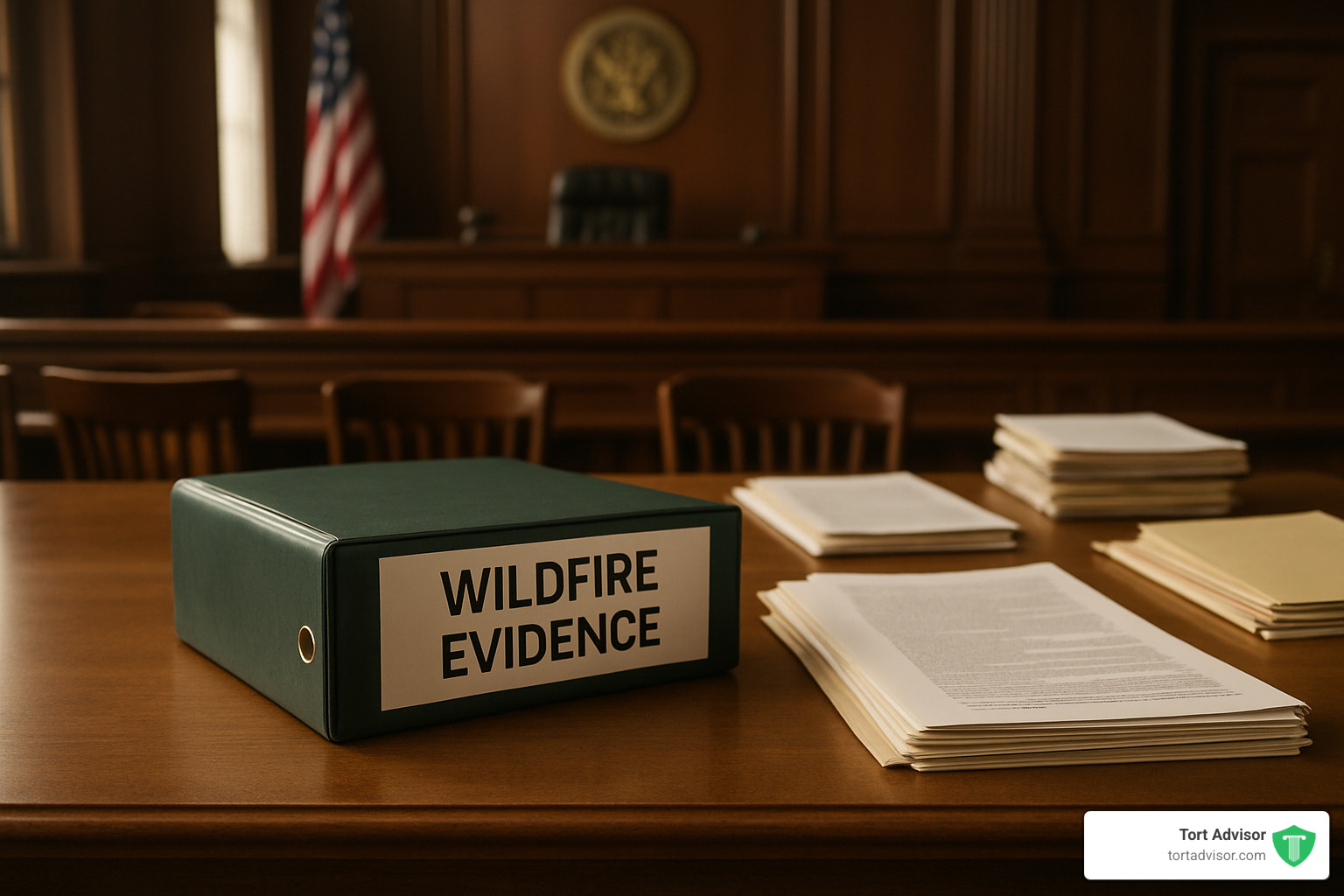
Understanding the legal journey ahead can provide comfort during an incredibly difficult time. While every case is unique, the process typically follows a predictable path.
Initial Consultation and Case Evaluation
Your first meeting with a wildfire attorney should feel like a conversation, not an interrogation. During this free consultation, your attorney will review what happened and help you understand whether you have a viable claim.
Most experienced wildfire attorneys work on contingency fees (typically 33-40% of any settlement), meaning you won’t pay attorney fees unless they recover compensation for your family.
Case Filing and Findy Phase
Once you decide to move forward, your attorney files a formal complaint in court. The findy phase is where your legal team gathers every piece of evidence that might support your case, including maintenance records, emergency response logs, and internal communications.
Expert witnesses play a vital role in California wildfire wrongful death cases. Fire investigators reconstruct how the blaze started, electrical engineers analyze equipment failures, and medical experts explain the cause of death.
Mediation and Settlement Negotiations
Most wildfire cases settle before reaching trial, often through court-ordered mediation. This process brings all parties together with a neutral mediator who helps facilitate settlement discussions.
Settlement negotiations require careful strategy. Your attorney will compare your case to similar outcomes, assess the strength of your evidence, and evaluate the defendants’ ability to pay.
Working With an Experienced Wildfire Attorney
The right attorney makes all the difference in these complex cases. Look for someone who maintains investigation resources including fire experts and electrical engineers. Quality attorneys invest heavily in expert witnesses and investigations because they understand what it takes to win.
Beyond legal expertise, the best wildfire attorneys provide family liaison services, keeping you informed about case developments and protecting your family from unwanted media attention.
For additional resources and case updates, families can explore our Wildfires section for comprehensive guidance on wildfire litigation.
Frequently Asked Questions About California Wildfire Wrongful Death
What is the deadline to file a California wildfire wrongful death lawsuit?
The statute of limitations for California wildfire wrongful death cases is generally 2 years from the date of death. However, several important exceptions and considerations apply:
Government Claims Exception: Claims against government agencies (Cal Fire, local fire departments, emergency management) must be filed within 6 months of the incident. This administrative claim is required before filing a lawsuit.
Findy Rule: In some cases, the deadline may be extended if the cause of death or responsible party wasn’t immediately apparent. For example, if utility negligence is finded months after the fire through investigation.
Minor Children: If the deceased left minor children, the statute of limitations may be tolled (paused) until the children reach age 18, allowing them to file their own claims.
Defendant Absence: If responsible parties leave California, the statute of limitations may be tolled during their absence.
Property Damage Claims: Separate 3-year deadline applies to property damage claims, which may be filed alongside wrongful death claims.
Missing these deadlines can permanently bar legal claims, making early consultation with an experienced attorney crucial.
Can multiple family members file separate claims?
California law establishes a priority system to prevent multiple competing wrongful death claims:
Single Lawsuit Requirement: Generally, all eligible family members must join in a single wrongful death lawsuit rather than filing separate cases.
Priority Order: The surviving spouse or domestic partner has the highest priority, followed by children, then parents, then other dependents.
Shared Recovery: Compensation is typically divided among eligible family members based on their relationship to the deceased and level of dependency.
Estate Representative: A personal representative may file on behalf of all eligible parties, especially when family members disagree about litigation strategy.
Survival Action Distinction: The deceased’s estate can file a separate “survival action” for the deceased’s own damages (pain and suffering before death, medical expenses), which is different from the family’s wrongful death claim.
Coordination Benefits: Joining together in a single lawsuit reduces legal costs, prevents conflicting strategies, and presents a unified case to defendants.
Are government agencies immune from wildfire wrongful death liability?
Government agencies have some legal protections, but they’re not completely immune from California wildfire wrongful death liability:
Discretionary Function Immunity: Government agencies are generally immune from liability for policy decisions (like resource allocation or strategic planning).
Ministerial Function Liability: Agencies can be held liable for failing to follow established procedures or maintain infrastructure properly.
Inverse Condemnation: Under California law, government agencies can be held strictly liable for property damage caused by their infrastructure, even without proving negligence.
Emergency Response Immunity: Limited immunity exists for emergency response decisions made under dangerous conditions.
Common Government Liability Areas:
- Failure to maintain water supply systems
- Delayed or inadequate evacuation orders
- Poor maintenance of fire suppression equipment
- Inadequate emergency communication systems
- Failure to follow established emergency protocols
6-Month Claim Requirement: Before suing government agencies, families must file administrative claims within 6 months, making early legal consultation essential.
Recent cases show government agencies facing liability for infrastructure failures, like the Santa Ynez Reservoir being offline during the Palisades Fire, which hampered firefighting efforts.
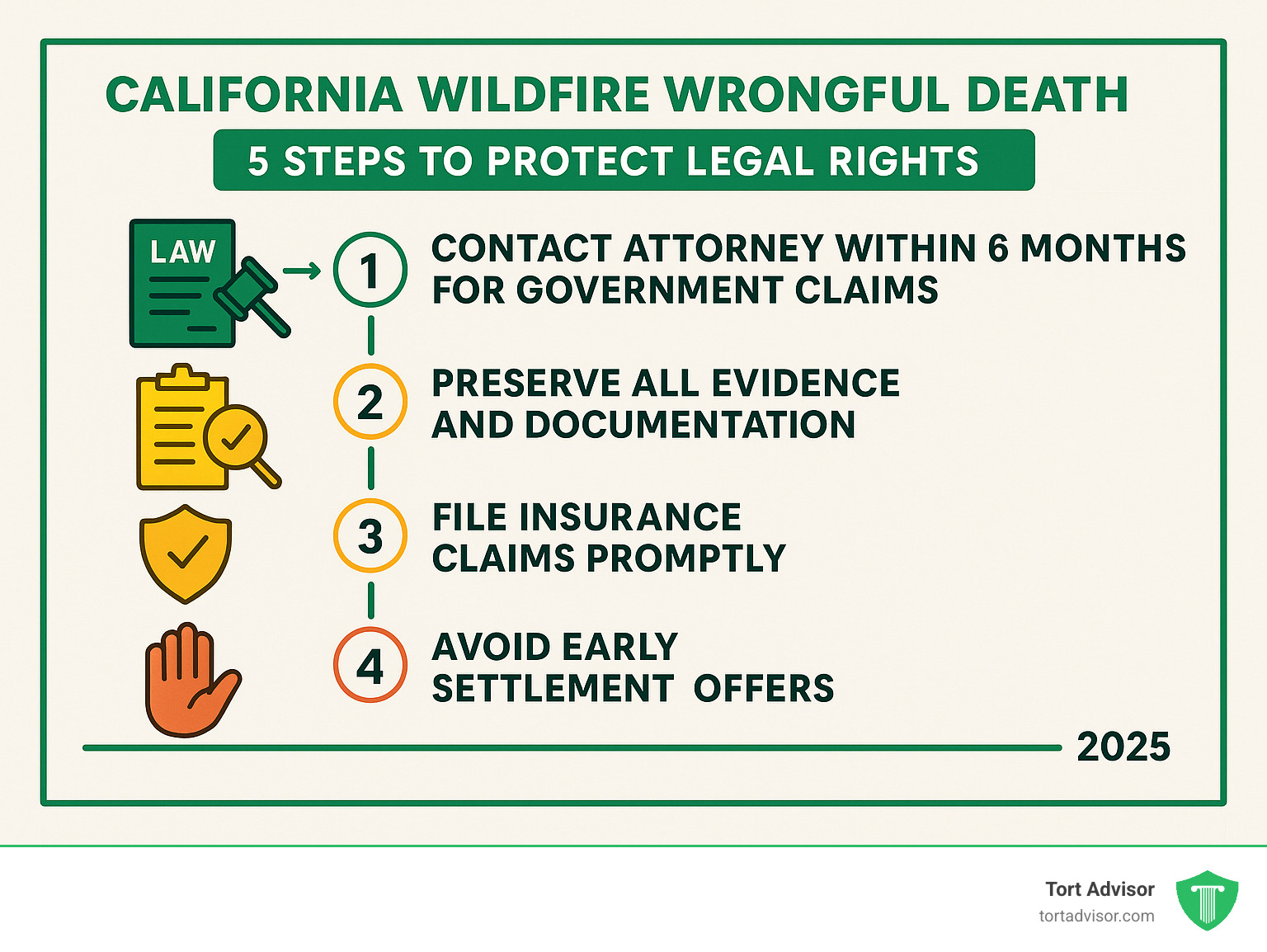
Conclusion & Next Steps
The journey toward justice after a California wildfire wrongful death is never easy, but understanding your legal rights can help provide both accountability and financial security for your family’s future.
The Path Forward
Immediate Actions
- Contact an experienced wildfire attorney for a free consultation
- Preserve all evidence related to the fire and your loved one’s death
- Document all expenses and losses from the incident
- File necessary insurance claims promptly
- Avoid signing any settlement agreements without legal review
Long-Term Considerations
- Understand that litigation can take 2-5 years or more
- Prepare for emotional challenges throughout the legal process
- Stay informed about ongoing investigations and related cases
Justice and Healing
While no amount of money can bring back a loved one, successful wrongful death litigation serves important purposes:
Accountability: Holding negligent parties responsible can prevent future tragedies and drive systemic safety improvements.
Financial Security: Compensation can provide for children’s education, replace lost income, and cover ongoing expenses.
Closure: The legal process can provide answers about what happened and why, helping families process their grief.
Working With Tort Advisor
At Tort Advisor, we understand that families dealing with wildfire wrongful death cases need compassionate advocates who understand the unique challenges of these complex cases.
Our network includes attorneys who specialize in California wildfire wrongful death litigation and have experience with:
- Major utility company negligence cases
- Government liability and inverse condemnation claims
- Complex multi-party litigation
- Insurance bad faith and coverage disputes
- Class action and mass tort coordination
We work exclusively with highly skilled attorneys who have proven track records in wildfire cases, ensuring families receive the specialized expertise these complex cases require.
Take Action Today
If you’ve lost a loved one in a California wildfire, time is critical. With deadlines as short as 6 months for government claims and 2 years for wrongful death cases, early action is essential to protect your family’s rights.
Don’t steer this difficult journey alone. Contact our experienced wildfire attorneys today for a free, confidential consultation to discuss your case and explore your legal options.
For ongoing information and resources, visit More info about Wildfire lawsuits for case updates and legal developments.
Your loved one’s life mattered, and their legacy can include making California safer for everyone. The path to justice may be challenging, but with the right legal team, families can find both the answers they seek and the compensation they need to rebuild their lives.

Free Confidential Case Evaluation
Complete the short form below to get an immediate FREE case review with an expert in your specific claim. Don't wait, your case could be time sensitive to file a claim.
Related Posts
Did a North Dakota product cause harm? Understand product liability, your rights, and how to take action for defects.
Get justice for clergy abuse. Find an expert Priest abuse lawyer to navigate complex laws and hold institutions accountable.
Diagnosed with meningioma after Depo-Provera? Understand potential Depo-Provera lawsuit settlements, risks, & how to claim compensation.
Uncover the truth about uber sexual assault cases. Learn about the alarming scale, Uber's accountability, and legal options for justice.
Facing wildfire losses? Discover the best wildfire lawsuit attorneys in California to fight for your full recovery and justice.
Exposed to Roundup & diagnosed with NHL? Discover how to sue Monsanto, understand eligibility, & seek compensation. Your guide to justice.



